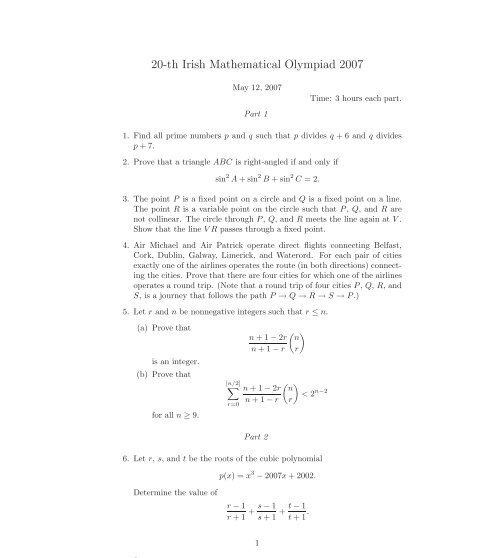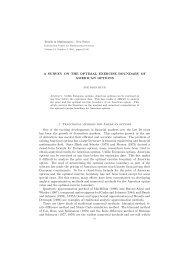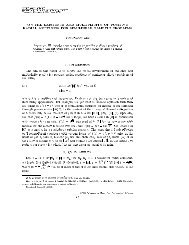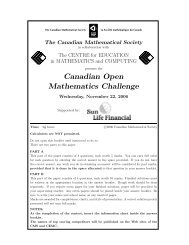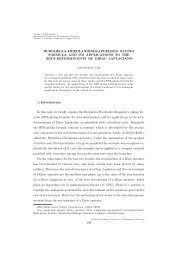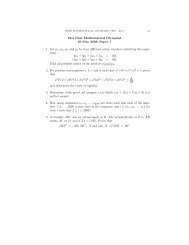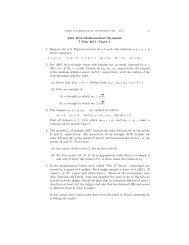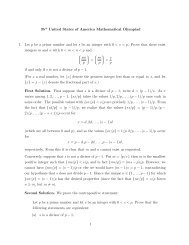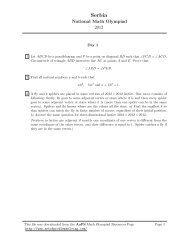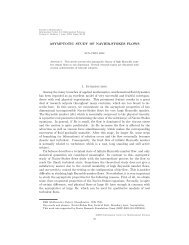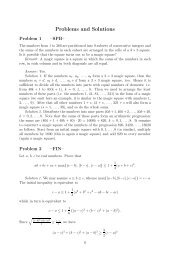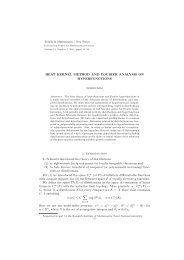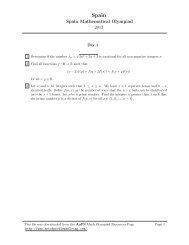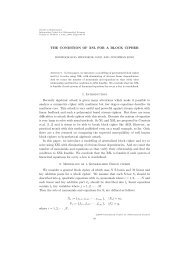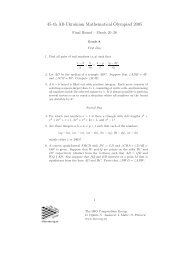20-th Irish Mathematical Olympiad 2007
20-th Irish Mathematical Olympiad 2007
20-th Irish Mathematical Olympiad 2007
You also want an ePaper? Increase the reach of your titles
YUMPU automatically turns print PDFs into web optimized ePapers that Google loves.
<strong>20</strong>-<strong>th</strong> <strong>Irish</strong> Ma<strong>th</strong>ematical <strong>Olympiad</strong> <strong>20</strong>07<br />
May 12, <strong>20</strong>07<br />
Time: 3 hours each part.<br />
Part 1<br />
1. Find all prime numbers p and q such <strong>th</strong>at p divides q + 6 and q divides<br />
p + 7.<br />
2. Prove <strong>th</strong>at a triangle ABC is right-angled if and only if<br />
sin 2 A + sin 2 B + sin 2 C = 2.<br />
3. The point P is a fixed point on a circle and Q is a fixed point on a line.<br />
The point R is a variable point on <strong>th</strong>e circle such <strong>th</strong>at P, Q, and R are<br />
not collinear. The circle <strong>th</strong>rough P, Q, and R meets <strong>th</strong>e line again at V .<br />
Show <strong>th</strong>at <strong>th</strong>e line V R passes <strong>th</strong>rough a fixed point.<br />
4. Air Michael and Air Patrick operate direct flights connecting Belfast,<br />
Cork, Dublin, Galway, Limerick, and Waterord. For each pair of cities<br />
exactly one of <strong>th</strong>e airlines operates <strong>th</strong>e route (in bo<strong>th</strong> directions) connecting<br />
<strong>th</strong>e cities. Prove <strong>th</strong>at <strong>th</strong>ere are four cities for which one of <strong>th</strong>e airlines<br />
operates a round trip. (Note <strong>th</strong>at a round trip of four cities P, Q, R, and<br />
S, is a journey <strong>th</strong>at follows <strong>th</strong>e pa<strong>th</strong> P → Q → R → S → P.)<br />
5. Let r and n be nonnegative integers such <strong>th</strong>at r ≤ n.<br />
(a) Prove <strong>th</strong>at<br />
is an integer.<br />
(b) Prove <strong>th</strong>at<br />
for all n ≥ 9.<br />
[n/2]<br />
∑<br />
r=0<br />
(<br />
n + 1 − 2r n<br />
n + 1 − r r)<br />
(<br />
n + 1 − 2r n<br />
< 2<br />
n + 1 − r r)<br />
n−2<br />
Part 2<br />
6. Let r, s, and t be <strong>th</strong>e roots of <strong>th</strong>e cubic polynomial<br />
p(x) = x 3 − <strong>20</strong>07x + <strong>20</strong>02.<br />
Determine <strong>th</strong>e value of<br />
r − 1<br />
r + 1 + s − 1<br />
s + 1 + t − 1<br />
t + 1 .<br />
1
7. Suppose <strong>th</strong>at a, b, and c are positive real numbers. Prove <strong>th</strong>at<br />
√<br />
a + b + c a2 + b<br />
≤<br />
2 + c 2 ab<br />
c<br />
≤<br />
+ bc a + ca b<br />
.<br />
3 3 3<br />
For each of <strong>th</strong>e inequalities, find <strong>th</strong>e conditions on a, b, and c such <strong>th</strong>at<br />
equality holds.<br />
8. Let ABC be a triangle <strong>th</strong>e leng<strong>th</strong>s of whose sides BC, CA, AB, respectively,<br />
are denoted by a, b, and c. Let <strong>th</strong>e internal bisectors of <strong>th</strong>e angles<br />
∠BAC, ∠ABC, ∠BCA, respectively, meet <strong>th</strong>e sides BC, CA, and AB at<br />
D, E, and F. Denote <strong>th</strong>e leng<strong>th</strong>s of <strong>th</strong>e line segments AD, BE, CF by<br />
d, e, and f, respectively. Prove <strong>th</strong>at<br />
def =<br />
4abc(a + b + c)∆<br />
(a + b)(b + c)(c + a) ,<br />
where ∆ stands for <strong>th</strong>e area of <strong>th</strong>e triangle ABC.<br />
9. Find <strong>th</strong>e number of zeros in which <strong>th</strong>e decimal expansion of <strong>20</strong>07! ends.<br />
Also find its last non-zero digit.<br />
10. Suppose <strong>th</strong>at a and b are real numbers such <strong>th</strong>at <strong>th</strong>e quadratic polynomial<br />
f(x) = x 2 + ax + b has no nonnegative real roots. Prove <strong>th</strong>at <strong>th</strong>ere exist<br />
two polynomials g, h whose coefficients are nonnegative real numbers such<br />
<strong>th</strong>at<br />
f(x) = g(x)<br />
h(x)<br />
for all real numbers x.<br />
2


